Ochs und Junior Due Ore reviewed

Ochs und Junior is the brain-child of Ludwig Oechslin and Beat Weinman and recently Ulysse Nardin came on board as the third partner. A logical third partner, if you know more about Oechslin’s achievements in the horological world. Since 2009 his ideas take shape in Ochs und Junior timepieces.
Ochs und Junior watches are recognizable by their clean and almost industrial design, lacking any kind of typical watchmaking finishing. And lacking any name or logo! The minimalistic design and raw, unfinished, machined parts determine the looks of all Ochs und Junior timepieces. Luckily I was allowed to borrow a Due Ore for a review. It’s a tough job, but somebody’s gotto do it…
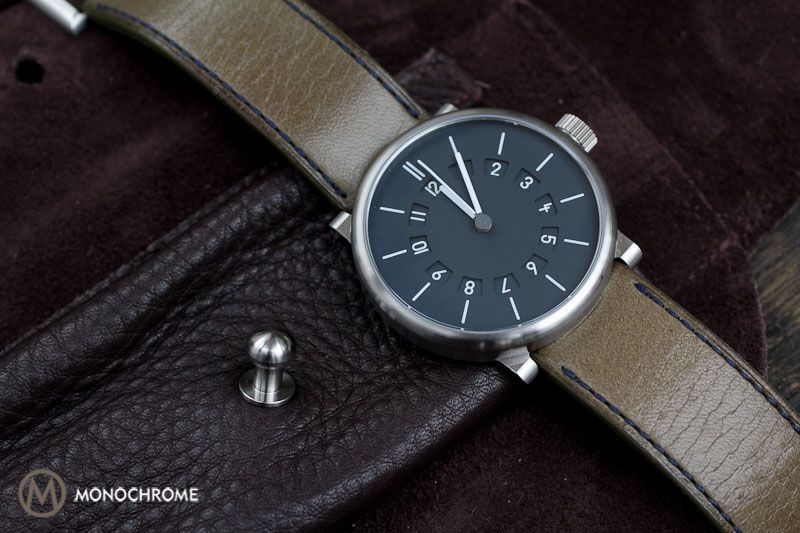
History
I wanted to say that the story began with Ochs und Junior’s first timepiece, the Anno Cinquanta, however that wouldn’t be correct. It actually began with the MIH Watch, a cooperation between Ludwig Oechslin, Beat Weinman from Swiss watch dealer The Embassy and designer Christian Gafner. Oechslin being curator of the Musee International d’Horlogerie in La Chaux de Fonds created this watch to generate funds for the restoration of the monumental Vachey Clock, a huge and very complicated clock. The MIH Watch, limited to 100 pieces per annum, is still available and for every sold MIH Watch 700 CHF is donated to the museum.

Beat Weinman and Ludwig Oechslin remained in contact and when Beat saw all the brilliant ideas Ludwig came up with, they decided there was much more that needed to be done. And thus the cooperation took a new shape as Ochs (ox in German) und Junior (… guess you all understand this). Early this year a third partner, Ulysse Nardin, joined Ochs und Junior, making sure they will have a steady supply of ETA movements (now Swatch Group terminates delivery to third parties). Another thing is that Ochs und Junior will also be able to use the brand new Ulysse Nardin in-house movement, caliber UN-118.
The first timepiece to be released under the Ochs und Junior flag was the Anno Cinquanta, which was available in gold and silver (!!) only. This watch, although it came in precious metal cases, came without any form of finishing. The idea was that (especially the silver) case would gain scratches, dings and of course patina over the years. By wearing the watch it really becomes your personal timepiece.
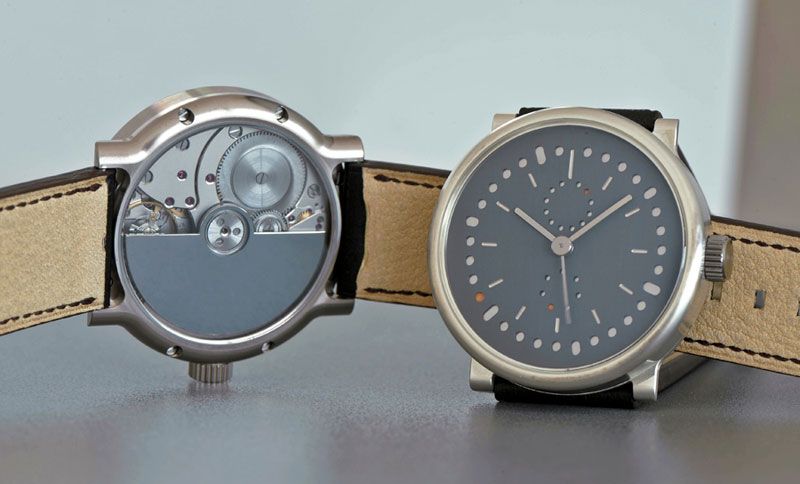
Inside the Anno Cinquanta ticks a beautiful movement, designed and build by Paul Gerber. A movement with a beauty and finish, that seems almost unusual for the (industrial) Ochs und Junior philosophy. Following models were introduced as ideas and prototypes first, slowly finding their way to become part of the collection. Since the last few years Ochs und Junior offers almost all of their models in the Tinta collection that is recognizable by the titanium cases and the possibility to choose your own color of the dial, hands and strap.
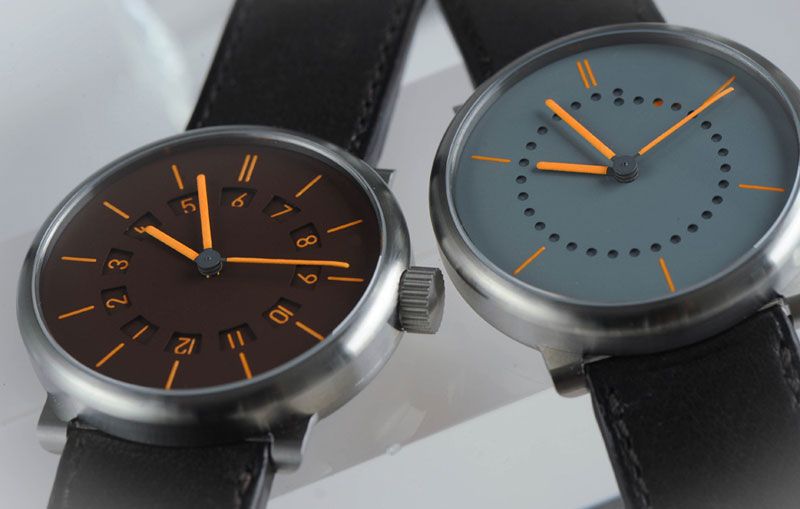
The watches in the Tinta collection are powered by the super-reliable and affordable ETA movements, allowing to keep prices between CHF 6,000 and CHF 8,000. The Due Ore Tinta, that I received for testing, is together with the Mese Tinta at the entry level of CHF 6,000. The Selena Tinta and the new Anno Tinta are available for CHF 8,000. One exception though; the Settimana Junior is available for just below CHF 3,000. The Settima Junior is Oechslin’s idea for a children’s watch, however it’s actually a perfect watch everyone who prefers a watch with a diameter of 36 mm.
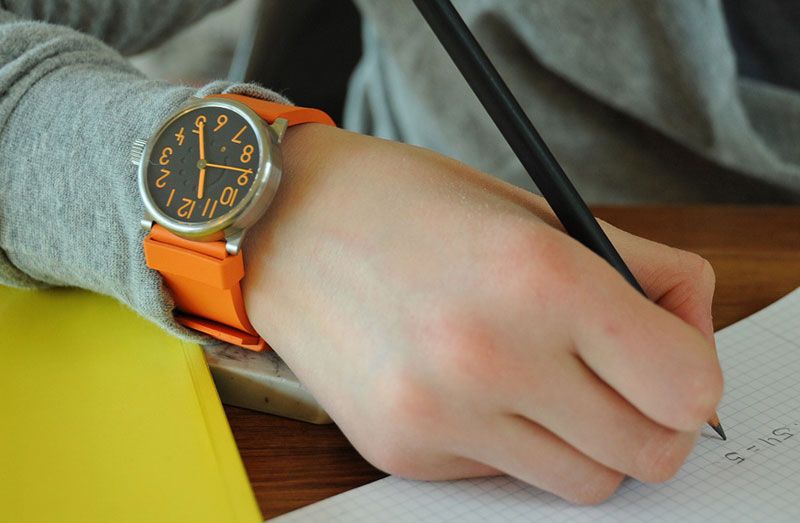
Now back to the Due Ore I got to wear… The Due Ore is part of the Ochs und Junior Tinta collection. All watches in the Tinta collection feature a titanium case, with a diameter of either 38 mm or 42 mm. The unfinished titanium case is manufactured by Peter Cantieni, who also manufactures titanium parts for the BMW Sauber Formula 1 cars. He produces all cases, dials, plates, hands and other mechanical parts for the OuJ ‘uncomplicated’ complications. And he makes the titanium button for the leather wallet you can use to wrap your Ochs und Junior watch in.
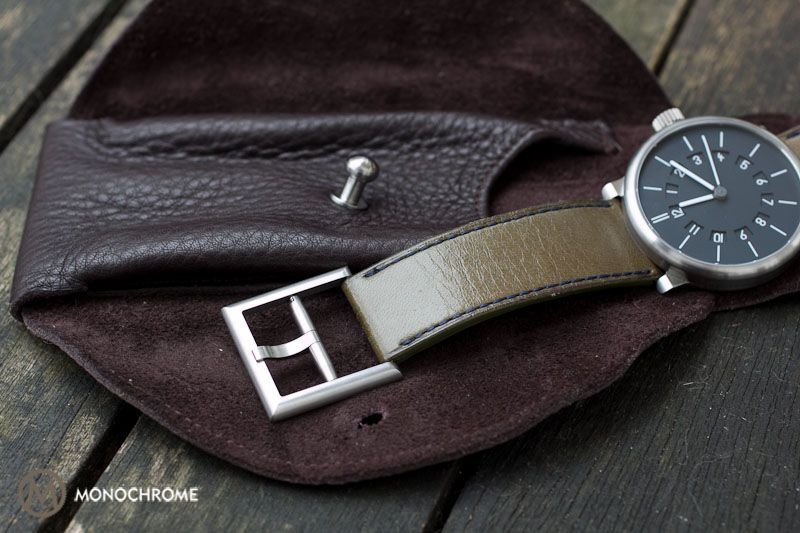
Slide the watch in and it looks like this…
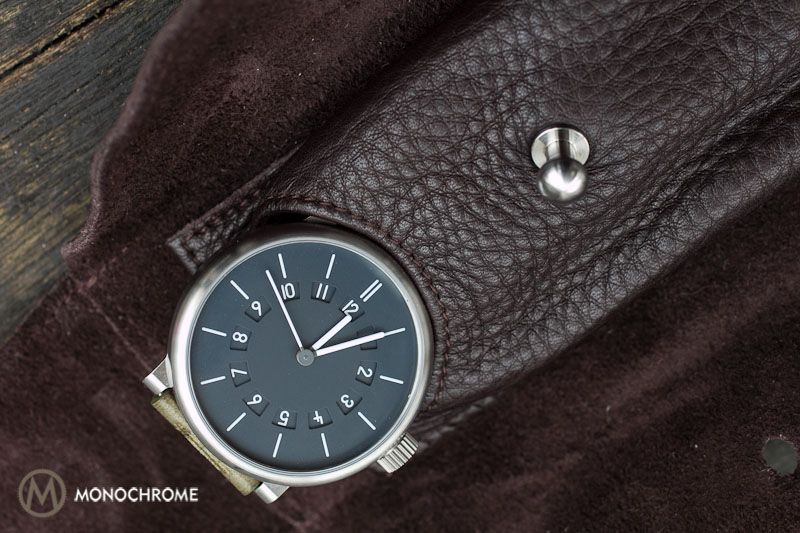
The word (and name of the collection) ‘Tinta’ stands for color. Simply meaning that you can choose the color of the dial from all available colors. You can also choose the color of the markers, hands, strap and stitching however from a limited number of colors. The version OuJ lend me for this review has a dark blue dial with light grey hands, numerals and hour markers. The olive green strap has navy blue stitching and matches beautifully with the dial and strap.
Overall appearance
When wearing an Ochs und Junior you know you wear a beautiful watch, yet there’s no high-polished finish, no shiny parts, no luxury glitter and glamour. So it’s more your own knowing that you’re wearing a luxury timepiece, that doesn’t have a luxury-recognition-factor like Rolex for instance.
The clean looks with almost bauhaus-like minimalistic design is unique among luxury timepieces. While wearing the Due Ore I received many compliment from people who usually never pay attention to watches. The Ochs und Junior timepieces are most likely meant for people who like to wear a good and reliable timepiece, but who don’t care for the typical luxury-looks almost all other watches feature.
The Ochs und Junior timepieces don’t have any logo or brand name, except a brand-mark on the inner side of one part of the strap. Yet another example of the unique minimalism of Ochs und Junior.
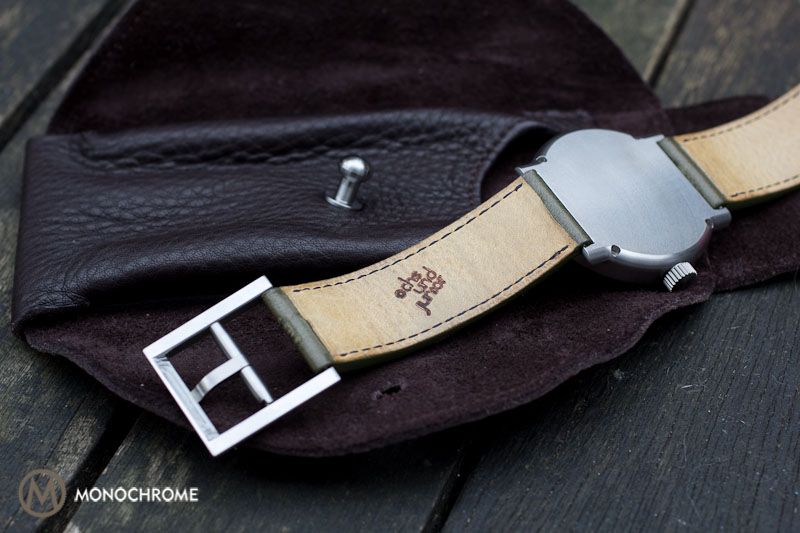
Features
The Due Ore features, like the name already says, a second time zone. In this case it’s bee done quite nifty, by replacing the date disk by another disk with numerals from one to twelve. Through twelve apertures in the dial, these twelve numerals are visible and enable you to see the time in a second time zone.
To adjust the second time zone, the disk with numerals can be turned via the crown. Simply put the difference in hours between your time zone and another time zone, in the aperture above the 12 o’clock position. You now use the hands to read your own time, but you must neglect the numerals. When you want to know the time in the second time zone, simply read the number next to the hour hand… et voila. In one blink of an eye you see the time in another time zone. It sounds easy and it also IS easy to adjust and to read.

Dial/hands
Like all watches from the Tinta collection, the color of dial, hands and indices is of your own choice. For the dial you can choose every possible color you can imagine. Just mention the ISO color code in your order and it will be done. The colors for hands, numerals and indices can be chosen from the options of luminescent material: orange, red, light blue, light green, camel brown, black, grey, lilac, yellow, white.
On this test model the dial is very dark blue, close to black, and the hands, numerals and indices are very light grey, almost white. What is really cool, is that the white paint used for hands, numerals and indices is luminescent. So it’s easy to read two time zones during day and night.
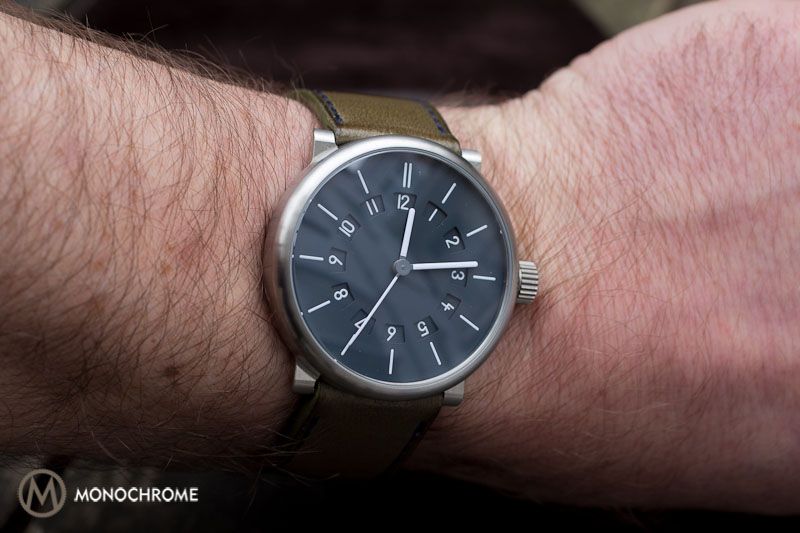
Case/strap
The titanium case is milled from one block of titanium and has not be ‘finished’ like usually happens in the watch industry. The case is a two part case, that comprises of a case back with lugs and the other part is both the mid-case as well as the bezel. This second part is secured with four screws, going through the case back. Titanium is one of the toughest metals used for watch cases and this has the advantage the case doesn’t scratch easy. A huge advantage in my opinion, because I wear my watches on almost all occasions, so some scratch-proofness is always welcome.
The sapphire crystal is treated with anti-reflective coating, but only on the inside. A smart choice, because the coating itself can get scratch by normal daily use. It happens to many watches and when it does, it actually starts looking ugly. So again a smart and practical choice.
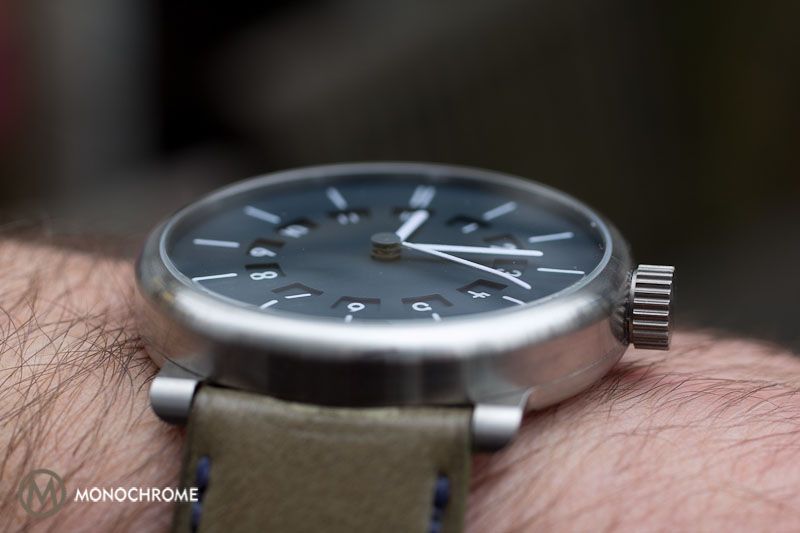
Because of the extremely short lugs and the rather thin case (10 mm) the Due Ore wears much smaller then one would expect based on the specified the 42 mm. I must admit that when I first saw the test watch I was convinced that the diameter was 38 or maximum 40 mm. So while 42 mm sounds like a rather large watch, it actually wears rather small and understated. The ‘understated’ is of course also debit to the un-finish case and minimalistic design.
The strap is an eco-tanned leather strap and the inside of one of the halves shows the Ochs und Junior brand mark. The color of the stitching is also of your own choice. And to close the strap, you can choose from a regular titanium tang buckle or this new design from Ludwig Oechslin. If you doubt… choose this one! No flappy remains of the strap that have to be kept close to the strap, it is now easily tucked away under the strap.
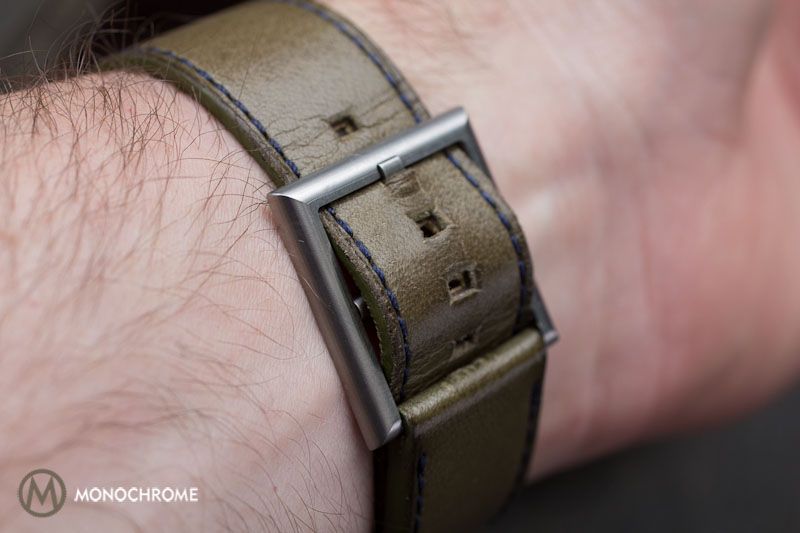
Movement
The only part that I don’t have to spent too many words on, is the movement. Inside all Tinta models ticks the über-reliable ETA 2824 that has served so many watch brands of all kinds of make.
Except… In the Due Ore the date mechanism has been altered and the date disk has been replaced. The 12-hour disk can be adjusted via the crown, similar to adjusting the date. The difference is that the date jumps after two full rotations of the hour hand. This does not happen with the 12-hour disk and the mechanism that is responsible for this automatic change of that disk has been removed. For the rest it’s the well-known ETA movement:
- automatic, date indication
- diameter: 11.5 ligne = 25.6mm, height is approx. 4.8mm
- 25 jewels
- b/h = 28.800
- power reserve 40h
The verdict – pros and cons
The size, the unfinished looks, the choice of colors, the minimalistic design, the “no logo”…. These things all add to what Ochs und Junior is doing. With most of these elements they are actually placing themselves outside the ‘normal’ watch industry’s business. And that’s probably what I like so much about the brand, the ideas and of course the watches.
Everything about the Due Ore feels good, solid, quality and while wearing it for a long time you won’t be disappointed. The one small thing I can nag about is that the ‘unfinished’ looks have a small downside to them, which is that the lugs are a bit sharp. You won’t cut yourself on them, absolutely not, but just when you go over them with the tip of your finger they feel sharp.
The second time zone function is incredibly basic, but it does exactly what it should do. It tells the time in another time zone and it does this in a very intuitive way. The watch functions perfectly, wears very comfortable and it’s always easy to read time on it.
One thing… the number of positive responses from friends and colleagues was impressive. Maybe not from the usual ‘hard core’ watch aficionados, but from people who usually never took a look at any of my watches before. Form follows function… I love it.
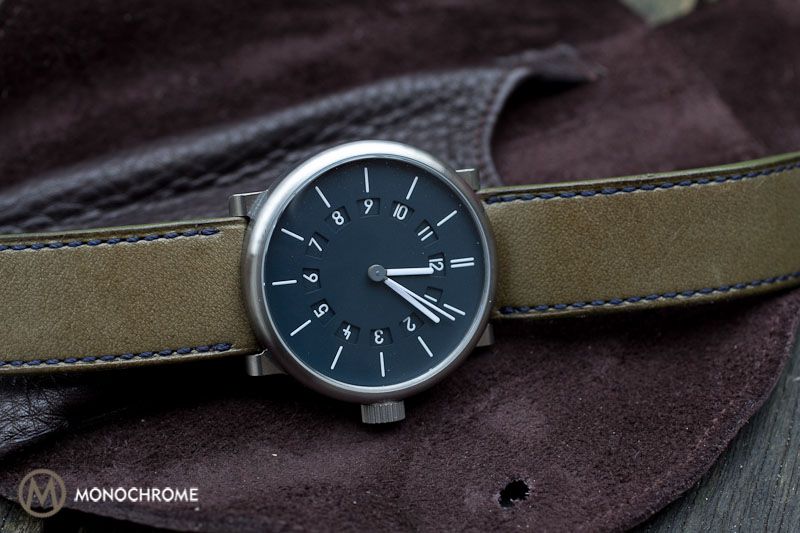
More information can be found on the Ochs und Junior website. They also have a great blog, the Ochsenblog and even share interesting news on their official Facebook page.
This article is written by Frank Geelen, executive editor of Monochrome Watches




2 responses
>> “Because of the extremely short lugs and the rather thin case (10 mm) the Due Ore wears much smaller then one would expect based on the specified the 42 mm.”
Wow, you aren’t kidding. Based on a couple of the pics I would have guessed 36mm-38mm. Great review and watch.
Indeed Chris, that was my initial thought as well. It’s a charm on the wrist and qualified for every activity, except deep sea diving.